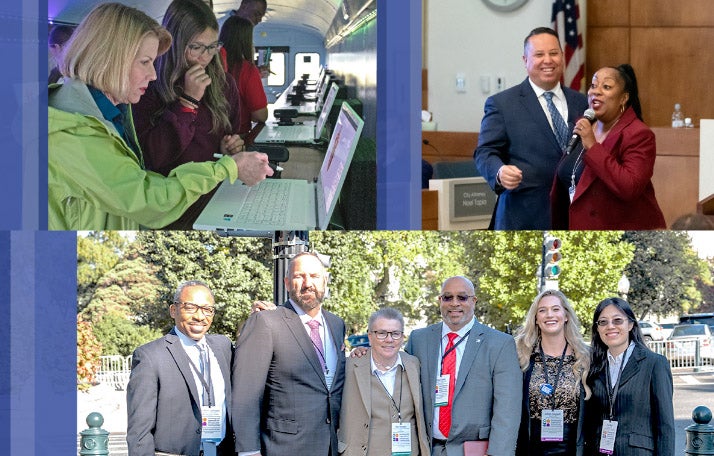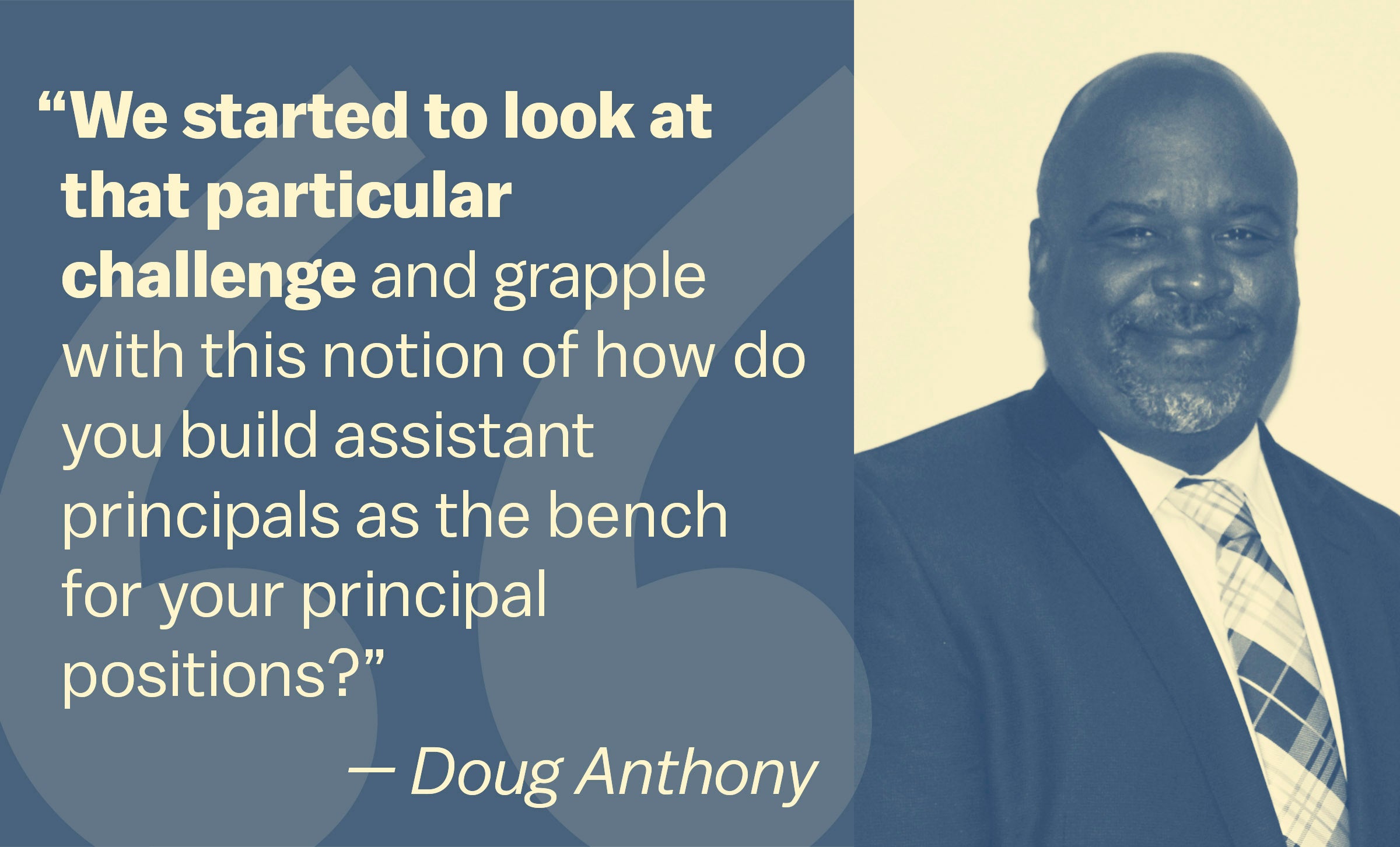Summary
This Principal Leadership magazine article examines ways in which principals can help assistant principals become stronger school leaders. Principals interviewed for the piece, which was written by Wallace Foundation writer Sarosh Syed, point to the importance of delegating leadership activities, using assistant principals’ strengths to address their weaknesses and building support for assistant principals in their new roles. Such efforts take time, but they can nurture the next generation of school leaders while also meeting important school needs, according to the piece. Wallace is learning about the relationship between principals and assistant principals through its Principal Pipeline Initiative, a six‑year, $75 million effort in six school districts to develop insights into how districts can create large numbers of effective school leaders.
Anyone who has been a principal knows that the job can be tough. You have to shape a vision for your school. You have to help teachers with lesson plans, keep students motivated, and secure resources from the central office. You have to manage budgets, monitor test scores, and support teachers whose students fall behind. And you do all of this knowing your job is critical: As a landmark 2004 study found, principals are second only to classroom instruction among school‑related factors that contribute to what children learn in school (Leithwood, Seashore Louis, Anderson, & Wahlstrom, 2004).
Few are ready for such a deluge of responsibility the first day on the job. To ensure that school districts can benefit from a steady stream of well‑prepared instructional leaders, you must also help develop the next generation of principals. That means cultivating leadership in your assistant principals, who may one day become principals themselves.
The Wallace Foundation is learning about the importance of the relationship between principals and assistant principals through its Principal Pipeline Initiative—a six‑year, $75 million effort in six school districts—to see if improved training for and management of principals can boost student achievement. Firm results aren’t due until 2018, but a recent report on the six districts’ early experiences suggests that if a district wants to improve the quality of its principals, it should consider cultivating its assistant principals as well (Turnbull, Riley, Arcaira, Anderson, & MacFarlane, 2013).
Principals in the six districts— Charlotte‑Mecklenburg, NC; Denver, CO; Gwinnett County, near Atlanta, GA; Hillsborough County, which includes Tampa, FL; New York City; and Prince George’s County, MD, near Washington, D.C.—are working to balance the needs of their schools with the needs of their assistant principals. Here are some of the ways they hope to meet both.
Share the Work
Mark Covington, principal of Samuel Ogle Middle School in Bowie, MD, faced a problem: His school had nine new teachers on board for the 2013–2014 school year. Three were falling short—test scores lagged, parents complained, and the teachers had trouble maintaining classroom discipline.
It takes time and effort to get struggling teachers up to speed. To get the job done, Covington would have had to fit into his crowded schedule hours to observe all three teachers in their classrooms, consult with instructional specialists, review the teachers’ lesson plans, and meet weekly with each teacher to review progress.
Covington’s approach to such challenges is simple—he shares the work with his two assistant principals, Glenise Marshall and Tamela Taylor‑Orr. This method doesn’t just free up Covington’s schedule; it also builds the skills and confidence of his seconds‑in‑command. “I try to release as much authority to my assistant principals as possible,” Covington said. “I think that helps them grow, so they feel like they have the autonomy to make the decisions and do what they think they need to do.”
Starting in November 2013, each administrator took responsibility for one teacher. They assigned their teachers readings from the school’s professional library, sat in on classes, arranged consultations with more experienced teachers, and worked with each teacher to create an improvement plan. The administrators also stayed in touch with each other, offering observations, sharing ideas, and determining the resources they needed to improve instruction. The teachers are showing progress, and Covington has noticed that the two assistant principals are growing as well. Administrative meetings were once one‑sided affairs, with Covington giving direction and assistant principals taking notes. Now he sees Marshall and Taylor‑Orr offering more of their own ideas. Conversations have become more technical as the two assistant principals grow more comfortable with the finer details of classroom observation. In addition, the assistant principals are learning from the teachers. Taylor‑Orr, who has been an assistant principal for eight years, lauds the opportunity to observe methods she didn’t study when she learned to be a teacher.
“To be a better administrator, you have to keep up with the trends,” she said. “I would say I learned to be a better administrator by some of the ideas that the new teachers are bringing in.”
Use Strengths to Address Weaknesses
Jesse Salters, an assistant principal at Blake High School in Tampa, FL, would seem to be an ideal candidate for a principalship. He has a master’s degree in educational leadership. He is in his ninth year as assistant principal at Blake. Five years ago, he was named assistant principal for student affairs; two years ago, he was promoted to assistant principal for administration, a position that’s just one step from the principalship. Plus, he’s well liked; he was one of Tampa’s most accomplished high school basketball players and garners respect and admiration from the students, especially the school’s athletes.
But he has been applying for a principalship in Hillsborough County for two years with little success. The problem, district officials told him, was that he didn’t have enough experience as an instructional leader.
But Blake principal Jacqueline Haynes came up with a plan: She put Salters in charge of all aspects of the education of the school’s athletes— health, meals, transportation, and most important, grades. She gave him a budget, assigned the students to his oversight, offered advice for how succeed in what she called “a school within a school” and then set Salters to work. He had to monitor the students’ test scores, determine where they were falling behind, and provide the resources they needed to improve. He had to review lesson plans, resolve conflicts between students and teachers, and lead meetings of teachers’ professional learning communities. He also had to cover anything he did with his own budget.
“It gave me the opportunity to do all the tasks that a principal would,” Salters said. “When you’re in charge of a school, everything is coming at you. You have to have a clear vision; you have to be focused; you have to know where to take the school.”
With this instructional experience under his belt, Salters is again interviewing for a principalship. “I’m feeling more prepared and more confident,” he said. “Of course, you can’t be fully prepared for what you’re going to step into. But having those experiences—dealing with curriculum, dealing with data— definitely allowed me to be a lot more prepared than if I hadn’t had this experience.
Get Colleagues on Board
In 2008, the School for Human Rights, a middle and high school in Brooklyn, NY, had an attendance problem. Thirty percent of the school’s 400 students were often absent. According to principal Michael Alexander, the school’s culture contributed to the problem. Students weren’t stimulated, some feared violence at school, and many weren’t disciplined for absences. He needed a dedicated program to change the culture, one that included an attendance committee, systems to track attendance, and incentives to improve it. And he needed a leader to guide the effort.
He turned to assistant principal Denise Jennings. Although Jennings had just arrived as an assistant principal, Alexander thought she had the skills the school needed; but more experienced staffers weren’t convinced. “They’d been doing this for a while,” said Alexander, “and they took some umbrage about having someone over them. They felt they could have done the job.”
Alexander worked with each staffer to build support for the project. On the one hand, he tried to persuade reluctant members of the new attendance committee that a coordinated effort under the leadership of an assistant principal was in the best interest of students. On the other hand, he counseled Jennings to be as inclusive as possible so committee members understood that their concerns were being heard. After two years of Jennings’s leadership, with counsel and support from Alexander, the School for Human Rights had a 92.9 percent attendance rate in 2012–2013, which placed it in the top quartile in the city. And although Jennings is undecided about pursuing a principalship, the experience left her feeling more confident.
“It moved me to find more experiences for myself,” she said. “I can move from attendance into trying to improve career and college readiness, trying to improve academics, addressing issues with young men, trying to get their graduation rates up. I’m sure that all of those things [will] help down the road if I choose to become a principal.”
Shifting Attitudes
Cesar Cedillo is principal of Bruce Randolph School in Denver, CO, a middle and high school of more than 900 students, 97 percent of whom qualify for free or reduced‑price lunch. Many students come from families with little formal education; they often assume that their education will end at high school. Seventy‑seven students graduated from Bruce Randolph in the summer of 2010. According to Cedillo, just 13 went on to college.
Cedillo had to help his students think of college as a realistic goal. He needed to motivate his students, expose them to postsecondary education institutions, and build their confidence in their academic abilities. He delegated the job to assistant principal Zach McDowell.
“I needed someone with their full eyes and energies in that project,” Cedillo said. “Based on his strengths and people skills, I thought that was a task that he could tackle.”
It takes more than just a pep talk to get 900 kids to believe in themselves. McDowell had to build partnerships with community colleges and scholarship funds. He had to recruit teachers to conduct college‑readiness seminars and teach college‑level classes. Most importantly, he had to shift attitudes: “The biggest challenge was advancing the mindset in the school about what our students were capable of accomplishing,” he said.
It was a long‑term project, and it wasn’t always pleasant. The school had to let go of five teachers to make room for college seminars, and McDowell sometimes got frustrated with onerous registration requirements to get his students enrolled in community college courses. According to McDowell, it took three years to see a change in the school’s college enrollment rates. To keep McDowell motivated, Cedillo suggested he focus on smaller victories along the way.
Offering AP classes at Bruce Randolph was one such victory. Getting Bruce Randolph students to take college‑level classes at the Community College of Denver was another. Recruiting the Denver Scholarship Foundation, a charity that helps students find financial aid, to set up an operation at Bruce Randolph was a third. But, while McDowell waited for enrollment rates to budge, the most helpful strategy was to focus on the less measurable changes in his students’ confidence.
“Cesar really gave me a lot of good feedback about not only the quantitative measures of increased enrollment but also the qualitative indicators that we need to build with our students, how the college seminar classes started building students’ confidence and their belief that they could accomplish college‑level classes,” McDowell said.
McDowell also got a boost by delegating part of his own job when he asked for volunteers to head up the new offerings at the school.
“All credit goes to the teachers,” he said. “When I put out the call for who could lead those seminar classes and who wanted to take on those postsecondary partnerships, those teachers really stepped up.”
College enrollment rates of Bruce Randolph graduates are starting to move, and so is Zach McDowell. Today he is a principal himself, overseeing the middle school while Cedillo tends to high school students, who may now be a little better prepared for college.
It’s Worth the Effort
Assistant principals have much to gain from a principal’s attention, especially experience that will serve them well when they step into the principal’s seat—but the principal benefits, too. Cesar Cedillo got a more motivated student body. Michael Alexander, in Brooklyn, NY, got a stronger attendance rate. Mark Covington, in Bowie, MD, got three teachers who are now on the road to proving themselves in the classroom.
Still, mentoring assistant principals comes with costs. Principals have to make time in their day to coach, troubleshoot, answer questions, and intervene when assistant principals feel overwhelmed. For principals such as Jacqueline Haynes in Tampa, FL, part of the payback is the knowledge that a mentored assistant principal today can mean a first‑rate principal tomorrow.
“I do it because I want to see our schools become better and our students have good educators,” she said. “I just take pride in producing a good product.”
References
Leithwood, K., Seashore Louis, K., Anderson, S., & Wahlstrom, K. (2004). How leadership influences student learning. Retrieved from Wallace Foundation website: https://wallacefoundation.org/sites/default/files/2023-07/How-Leadership-Influences-Student-Learning.pdf
Turnbull, B. J., Riley, D. L., Arcaira, E. R., Anderson, L. M., & MacFarlane, J. R. (2013). Six districts begin the principal pipeline initiative. Retrieved from Wallace Foundation website: https://wallacefoundation.org/sites/default/files/2023-06/Six-Districts-Begin-the-Principal-Pipeline-Initiative.pdf
Wallace Foundation. (September 2014). Cultivating leadership: Case studies in developing assistant principals. Prepared by the Georgia Leadership Institute for School Improvement for the Principal Professional Learning Community, as part of the Wallace Foundation’s Principal Pipeline initiative




